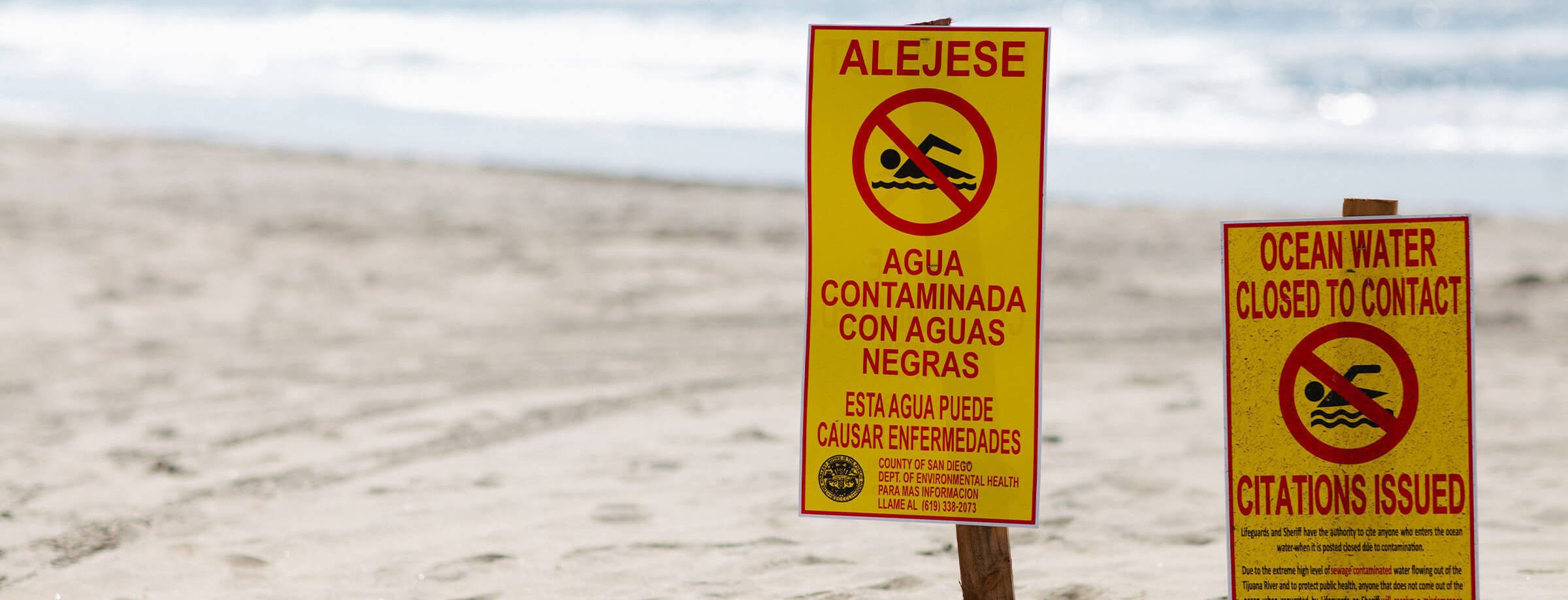
Americans love the beach. Over 100 million beachgoers flock to U. S. beaches every year to enjoy the sand, sunshine and water. With limited recreation options during the COVID-19 pandemic, beach attendance soared in 2020 and was up as much as 200-300% in some states. Not only do beaches provide recreation, leisure and social opportunities but they are the foundation of valuable coastal tourism and ocean recreation economies worth over $130 billion providing 2.4 million jobs nationwide (oceaneconomics.org).
The Threats
Despite the high value of clean beaches, coastal water quality is threatened by stormwater, urban & agricultural runoff, sewage and industrial discharges. Years of neglect, have left America’s wastewater infrastructure in disrepair, outdated and failing. Sewage spills and failing wastewater infrastructure threaten coastal water quality by discharging raw and under-treated sewage into local waterways and the ocean. In fact, sewage spills and infrastructure failures release over 900 billion gallons of untreated sewage into surface waters every year!
Sewage can contain bacteria, viruses & parasites that make people sick with gastro-intestinal symptoms, rashes, skin and eye infections, flu-like symptoms, and worse. Sewage discharges also pollute waterways with excess nutrients that wreak havoc on coastal ecosystems by fueling harmful algal blooms that put human health at risk and result in fish kills and coral reef die-offs.
Where is all this poo coming from?
America’s aging sewers, nearing 100 years old in many cities, are overwhelmed and failing under stress caused by decades of neglect, growing populations and climate change. This results in frequent failures, such as line breaks, pump failures, and overflows. In Florida, sewage spills have become a widespread problem. Over the last five years, the Department of Environmental Protection reported nearly 14,000 sewage spills that released over 1.6 billion gallons of sewage into communities and surface waterways across the state.
Many communities are not even connected to sewers but instead rely on cesspools and septic systems. These antiquated systems never adequately treat sewage but instead allow household waste to leach into ground and surface waters. Approximately 25% of U.S. households are still serviced by these disposal systems, and nearly 50% in some states, especially in rural areas. And we’re not just talking about farm country here. There are nearly 88,000 cesspools in Hawaii that discharge 53 million gallons of sewage into coastal waters every day. On the East End of Long Island, there are approximately 360,000 on-site sewage disposal systems of which 250,000 are cesspools - basically no more advanced than a deep hole in the ground.
Stormwater and flooding conditions that cause groundwater levels to rise, further complicate this situation causing septics and cesspools to leach out effluent. In sewered areas, stormwater can infiltrate into old pipes overwhelming the entire system and causing overflows of undertreated sewage into coastal waters. Add sea level rise and extreme weather events associated with climate change into the mix and it’s a true recipe for disaster.
Surfrider’s Approach
To protect water quality along our coasts, we are working to ensure that all sewage in the United States is adequately collected and treated to protect public health and the environment. To achieve this goal we are advocating for robust beach water quality monitoring programs through the federal BEACH Act and we are filling in the gaps of government-run beach programs with our Blue Water Task Force volunteer water testing program so beachgoers have the information they need to stay safe at the beach. We are also calling on Congress to make significant investments this year to start catching up on the backlog of sewage infrastructure upgrades needed across this country to prevent under-treated sewage from entering our waterways. Investments in water infrastructure will also help put Americans back to work and will provide long-lasting benefits to the nation’s economy.
With our grassroots network mobilized around this issue we are also bringing together local communities to build awareness of water quality problems so the causes can be found and fixed. In Florida, we are working to secure state funding for the Florida Healthy Beaches water quality testing program, and improving public notification practices used to inform beachgoers of elevated bacteria levels and sewage spills. In Hawaii, our chapters are advocating for improvements to beach water quality monitoring and public notification programs to better protect safe coastal recreation. We are also working with partners to protect coastal water quality by phasing out the use of cesspools across the state. Read more about our campaigns in Hawaii and Florida.
Along the U. S./Mexico Border, the San Diego Chapter is running a campaign to eliminate the flow of trash, chemicals and untreated sewage into the Pacific Ocean and onto San Diego County beaches. The situation is so dire, that beaches adjacent to the Tijuana River Valley were closed to protect the public from exposure to these pollutants nearly 300 days in 2020! The San Diego Chapter is working hard to raise community awareness and build the political will necessary to solve the border region’s sewage infrastructure problems through their Clean Border Water Now campaign. Their goal is to restore coastal water quality conditions regionally so local families can once again enjoy recreating at the beach without having to worry about getting sick. This is what is driving Surfrider’s efforts at protecting water quality across the nation. We want to ensure that the beach and ocean are clean and safe for all people to enjoy for generations to come.
Take Action Today
Please join us in our efforts to Stop Sewage Pollution and ask your representatives in Congress to make a bigger federal investment to meet the sewage infrastructure needs of our growing communities across the country. Email Congress here.
Learn more about how sewage ends up at the beach and ways we can all tackle these sources of pollution together on our Stop Sewage Pollution campaign page.